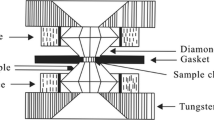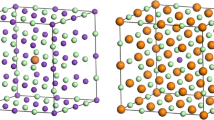Abstract
H2O activities in supercritical fluids in the system KCl-H2O-(MgO) were measured at pressures of 1, 2, 4, 7, 10 and 15 kbar by numerous reversals of vapor compositions in equilibrium with brucite and periclase. Measurements spanned the range 550–900 °C. A change of state of solute KCl occurs as pressures increase above 2 kbar, by which H2O activity becomes very low and, at pressures of 4 kbar and above, nearly coincident with the square of the mole fraction (x H2O). The effect undoubtedly results primarily from ionic dissociation as H2O density (ρH2O) approaches 1 gm/cm3, and is more pronounced than in the NaCl-H2O system at the same P-T-X conditions. Six values of solute KCl activity were yielded by terminal points of the isobaric brucite-periclase T-x H2O curves where sylvite saturation occurs. The H2O mole fraction of the isobaric invariant assemblage brucite-periclase-sylvite-fluid is near 0.52 at all pressures, and the corresponding temperatures span only 100 °C between 1 and 15 kbar. This remarkable convergence of the isobaric equilibrium curves reflects the great influence of pressure on lowering of both KCl and H2O activities. The H2O and KCl activities can be expressed by the formulas: a H2O = γH2O[x H2O+(1 + (1 + α)x KCl)], and a KCL = γKCl[(1 + α)x KCl/(x H2O +(1 + α)x KCl)](1 + α), where α is a degree of dissociation parameter which increases from zero at the lowest pressures to near one at high pressures and the γ's are activity coefficients based on an empirical regular solution parameter W: ln γi = (1 − xi)2W. Least squares fitting of our H2O and KCl activity data evaluates the parameters: α = exp(4.166 −2.709/ρH2O) − 212.1P/T, and W = (−589.6 − 23.10P) /T, with ρH2O in gm/cm3, P in kbar and T in K. The standard deviation from the measured activities is only ± 0.014. The equations define isobaric liquidus curves, which are in perfect agreement with previous DTA liquidus measurements at 0.5–2 kbar, but which depart progressively from their extrapolation to higher pressures because of the pressure-induced dissociation effect. The great similarity of the NaCl-H2O and KCl-H2O systems suggests that H2O activities in the ternary NaCl-KCl-H2O system can be described with reasonable accuracy by assuming proportionality between the binary systems. This assumption was verified by a few reconnaissance measurements at 10 kbar of the brucite-periclase equilibrium with a Na/(Na + K) ratio of 0.5 and of the saturation temperature for Na/(Na + K) of 0.35 and 0.50. At that pressure the brucite-periclase curves reach a lowest x H2O of 0.45 and a temperature of 587 °C before salt saturation occurs, values considerably lower than in either binary. This double-salt eutectic effect may have a significant application to natural polyionic hypersaline solutions in the deep crust and upper mantle in that higher solute concentrations and very low H2O activities may be realized in complex solutions before salt saturation occurs. Concentrated salt solutions seem, from this standpoint, and also because of high mechanical mobility and alkali-exchanging potential, feasible as metasomatic fluids for a variety of deep-crust and upper mantle processes.
Similar content being viewed by others
Author information
Authors and Affiliations
Additional information
Received: 9 August 1996 / Accepted: 15 November 1996
Rights and permissions
About this article
Cite this article
Aranovich, L., Newton, R. H2O activity in concentrated KCl and KCl-NaCl solutions at high temperatures and pressures measured by the brucite-periclase equilibrium. Contrib Mineral Petrol 127, 261–271 (1997). https://doi.org/10.1007/s004100050279
Issue Date:
DOI: https://doi.org/10.1007/s004100050279




